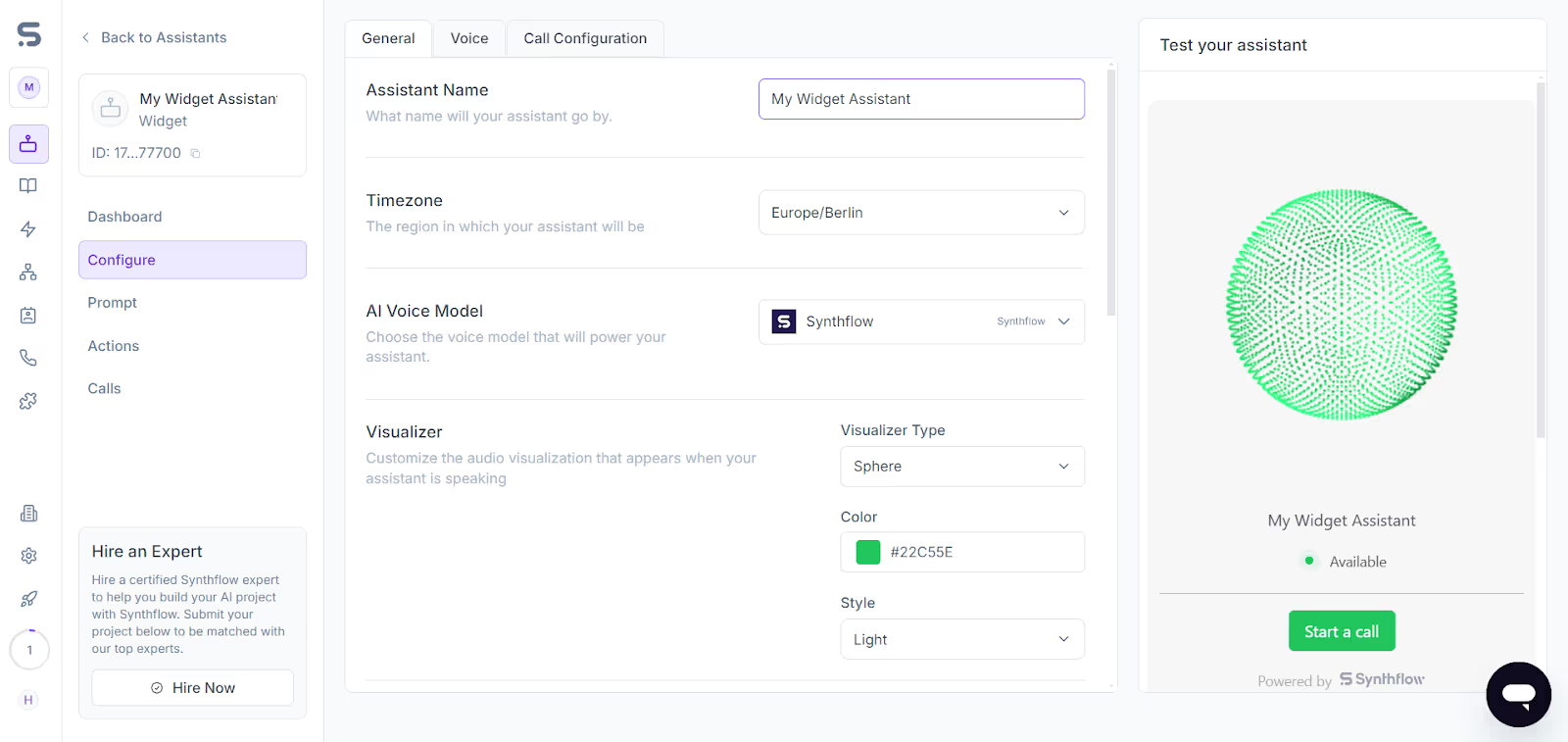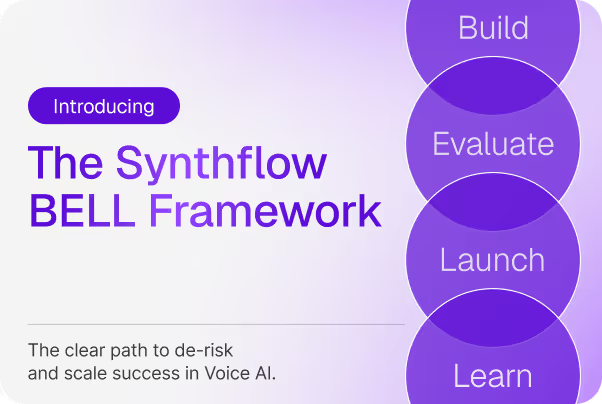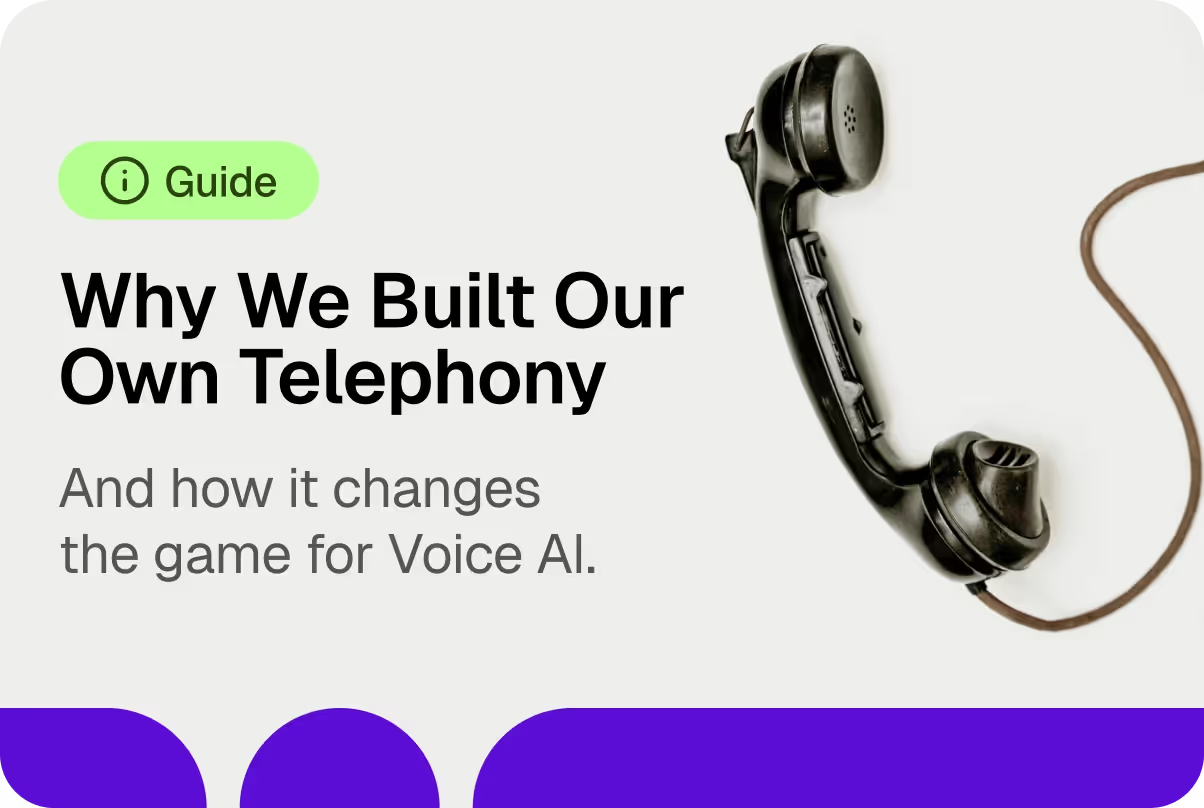Conversational AI
How to Build an AI Voice Assistant with Synthflow AI

Table of Contents

There are many reasons why you may want to make your own AI voice assistant or chatbot. Perhaps you wish to create a virtual “call centre” to provide quick customer support. Alternatively, you would want to scale your marketing efforts and reach more people to educate them about your product or service.
But the question is, how do business owners build and incorporate the technology into their products? There are a lot of challenges a business can face with implementing an AI voice agent:
- Lack of contextual understanding
- Data privacy and security concerns
- Limited integration capabilities
- Continuous learning and adaptation
AI projects can typically take anywhere between three to 36 months, depending on the scope and complexity of the use case. The timeline to deploy an AI voice agent cannot be neglected. That’s why you need to implement an AI voice agent like Synthflow AI that takes care of the challenges of implementing an AI voice agent and helps you get started in minutes. It’s no-code, enterprise-ready capabilities and easy drag-and-drop interface will help you quickly implement an AI voice agent for your business. In this blog, we will help you create and set up an AI voice agent with Synthflow AI, including its use cases, benefits, and future applications. Let’s get started. What is Synthflow AI?

Synthflow AI is an AI-powered phone calling system built to answer your phone calls anytime. The in-built 11Labs integration enhances its AI capabilities to understand and respond to customers just like a real person would. You can choose from hundreds of different voices or clone your voice. Syhthflow guardrail top LLMs like Llama and OpenAI’s GPT-3 through GPT-4o. It also offers multilingual and accents—from Australian and British to Argentinian Spanish to support effective communication. This makes it a versatile tool for global businesses.That means zero lag, so conversations feel natural, and responses are quick with no awkward pauses. Synthflow’s features are highly advanced compared to those of its competitors, and its use cases are well-suited for any business looking to automate aspects of its sales and marketing seamlessly. Benefits of Using Synthflow AI for AI AssistantsAre you tired of the endless cycle of hiring, training, and managing call center agents?Imagine a tool that can handle all your customer interactions seamlessly, anytime. That’s Synthflow. This isn’t your average phone system. It’s packed with powerful features that transform the way you handle customer calls. Let’s explore some of the standout benefits that set Synthflow apart:Real-Time Voice Interactions
Synthflow supports real-time voice interactions, making it suitable for live applications such as customer service or real-time data inquiries. With multilingual capabilities, a diverse voice library, and advanced voice synthesis that helps deliver human-like, engaging conversations. Their extensive voice library allows clients to perfectly match voiceovers to the specific needs of the audience, adapting seamlessly to global and local markets. It promotes a variety of language models, including:
- Claude-1.0
- Claude-2.0
- davinci-003
- GPT-3.5-turbo
- GPT-4
- GPT-3.5-turbo-0613
- GPT-4-0613
- GPT-3.5-turbo-16k
You don’t have to pay extra for any LLM; you only have to pay Twilio. All of the above language models deliver natural responses and complex language understanding and are easy to tailor in Synthflow’s dashboard.High Performance and scalability
Synthflow offers a user-friendly, no-code platform with a drag-and-drop interface to help businesses launch their voice agents without any technical experience. The setup is simple and requires no programming knowledge.One of its users mentions, “I have tried a number of Voice AI services and Synthflow is miles apart from anyone else. Their platform is more extensive and easier to use than any other product out there. The agents are easy to toast up and connect to whatever system you want them to.”Synthflow’s versatility and ease of use empower developers and content creators to implement voice technology efficiently, ensuring that every digital interaction is as human-like and engaging as possible. Easy Customization
Sythflow provides maximum customization with pre-built templates, custom integrations, and workflows that are tailored to your specific needs.It uses unique custom models that provide customized Performance and accuracy by owning and deploying models for particular applications and sectors without sacrificing speed or efficiency. Synthflow AI offers integration capability to some of the most powerful integration capabilities, including Hubspot, Zapier, ClickFunnels, Cal.com, Make.com, and more. You can seamlessly integrate your current tech stack with Synthflow AI hassle-free. Step-by-Step Guide to Creating an AI AssistantAs the saying goes, ‘A journey of a thousand miles begins with a single step.’ Here’s the step-by-step process of creating your next AI assistant at Synthflow AI:Step 1: Setting Up Your Synthflow AccountSo once you log into your account, this is going to be the first screen you’re going to see. All you’re going to need to do is go up to the top right-hand corner, and press create, and then you can choose from creating a new assistant through one of the three methods.

We also have a knowledge base, and this is going to be where you’re going to upload things like your website or some text documents so your assistant has some information that it could reference on some calls. Step 2: Creating a Chatbot WidgetGo to “Create Assistant,” and then click on “Start from scratch” and select “Widget”.

Give your widget a name and add information like its timezone, color palette, and custom vocabulary to personalize its look and feel. You also have to add a detailed prompt that lays grounds for how your chatbot will interact with callers.

Synthflow AI already provides you with a ton of prompt templates that you can edit according to your business needs. Or, use Synthflow’s prompt AI to help you quickly generate detailed and accurate prompts.

Click next. You’ll have to pick a phone number, configure a campaign, add the budget to it and finish now the agent is finished. After that, you go under deployment. Once your widget is ready for deployment, you can directly copy the code of your chatbot directly on your app or chatbot.

Think of this chatbot widget as a little chat bubble down here on your website where people can engage with the chat to find information about your product or service.Step 4: Integrating with ZapierOnce you add in your budget and phone number, you can now proceed to integrate your voice assistant to Zapier. You’ll directly reach the Zapier page once you click on “Create Zap.” The first step you’re going to add is the trigger.

Fill in the following on the required sections:App & event: Choose Synthflow AIEvent: Select voice phone callAccount: Copy your API key from the last page (where you clicked on “create zap” ”)Trigger: Copy your model ID from the last page (beside the API key number)

You can now test your trigger from the inbound zapier page. Write in the receiver’s phone number and their name. Click on the call button to send the call through Syhthlow AI voice assistant. Step 5: Testing and DeploymentWhen you’re building a voice assistant, one of the things you need to do before you deploy it into the world and let it start speaking to customers and users is actually testing it to see that it’s doing exactly the thing you want to do. Quickly test your call by clicking on the “Test Trigger” option. Now, you should be able to findout once the call is completed.

You will have the lead name, phone number, time zone, call ID, call duration, transcript, and executed actions if you added any entity extraction or bookings or stuff.Once satisfied, you can scale your AI calling efforts by creating inbound, outbound, or widget campaigns directly from Synthflow AI. Use Cases for AI Assistants Built with Synthflow AISynthflow AI opens a variety of use cases for many industries. Thanks to Machine Learning and Natural Language Processing (NLP), today’s voice assistants are seen as scalable tools that enhance customer experience and increase operational efficiency. Here are some of the benefits of deploying AI assistants built with Synthflow AI:
- Customer Support Automation
A long wait time is cited as one of the main reasons why a customer stops doing business with a company. The average wait time a customer takes to talk to a live agent is 2 minutes and 40 seconds. While several chat agents were able to respond within 30 seconds, the longest wait time recorded was 9 minutes. That’s a long time to keep your customers waiting.

SourceInstead of leaving conversations completely on human agents, you can extend it to Synthflow AI assistants. AI voice bots excel at resolving customer queries and providing immediate assistance. One of the standout benefits of Syhthflow AI chatbots and voice bots is their 24/7 availability. This availability is helpful for getting answers, resolving issues, or addressing complex queries at any time.
- Lead Generation
Getting enough quality leads in the pipeline is the top priority for the vast majority (91%) of marketers. But we don’t need to tell you twice. That’s no simple task.

Generating leads costs marketers more than half of their marketing budgets. And everybody is in search of a solution to do it more effectively and efficiently. Synthflow AI attacks the issue from all angles, from scaling outreaching efforts over voice, text, email, and chat to lead scoring and segmentation. It helps businesses segment their leads and prioritize them accordingly. Your AI assistant collects relevant information and auto-generates personalized conversations based on prior conversations. This way, you can automate lead outreach and follow-up without needing any human involvement.
- Improved customer Insights
AI-powered conversational voice bots like Synthflow AI provide a wealth of insights into customer behavior, pain points, and preferences. With voice bots, you can record your customer calls to:
- Spot trends
- Find upsell/cross opportunities
- Make sure staff are asking the right questions
- Ensure voice bots are adhering to script/questions that increase revenue
You can also monitor the call performance of your agent to get more insight into the customer experience. Your voice bots provide details on the following:
- Average daily calls
- Total talk time
- Your preferred keywords spotted in conversations
- And more
This data-driven approach not only strengthens decision-making but also helps personalize experiences, boosting loyalty and retention. Best Practices for Building AI AssistantsBuilding AI assistants requires a combination of technical expertise, user-centric design, and ethical considerations. Below are the best practices for creating AI assistants:
- Identify the Core Use Case: The first step in developing a good AI assistant is writing down your core use cases. Will this be a customer service chatbot, a productivity app for scheduling tasks, or an outreach assistant for marketing and sales? A clear purpose will affect both the furtherAI’ss training and UI/UX design.
- Ensure data quality: The Performance of your AI assistant relies heavily on the quality of the data used during the training. There are many different types of data sets required for AI voice assistants.
- Data Cleaning: Remove duplicates and irrelevant entries.
- Data Labeling: Clearly define intents for supervised learning.
- Balancing the Dataset: Ensure diverse examples across all potential inputs to avoid bias.
- Implement Robust Testing and Validation: Before deployment, rigorously test your AI assistant to ensure it meets performance expectations.
- Simulated User Testing: Evaluate how well the assistant handles various queries.
- Feedback Loop: Incorporate user feedback to refine responses and improve functionality
- Keep your prompts simple and clear: Don’t overload your prompts by adding too much information. Be concise and direct. Only include important details to get tailored, accurate responses. Vague prompts provide generic answers that will affect your assistants. Performance and hamper the experience of your customers.
Wrapping up Building an AI assistant is a challenging yet fulfilling endeavor. It empowers you to develop a distinctive assistant that replaces the need to hire, train, and manage human agents. Having a clear objective, selecting the appropriate tech stack, and maintaining unwavering determination can help you create an excellent AI voice assistant. And, Synthflow AI can help you in many ways possible. Whether you are a techie or not, Synfthow helps you create AI voice assistants in minutes. Synthflow’s features are highly advanced, and its use cases are well-suited for any industry looking to automate aspects of its sales and marketing seamlessly. Want to try a free demo to see how you can replace your traditional call centers with AI voice bots? Sign up here.



.avif)